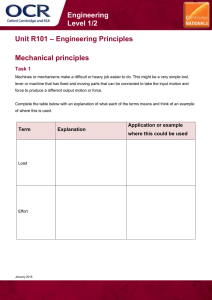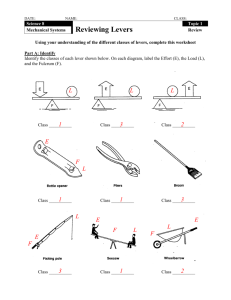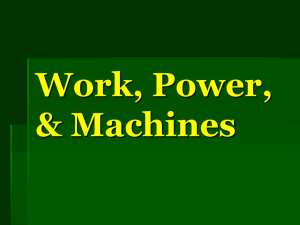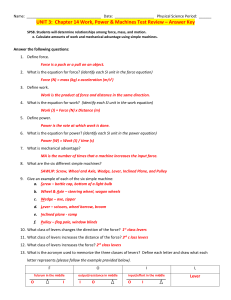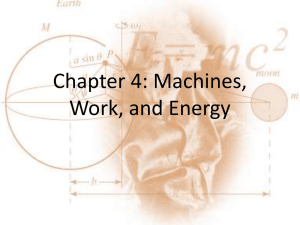PowerPoint Presentation - Work, Power, & Simple Machines
advertisement
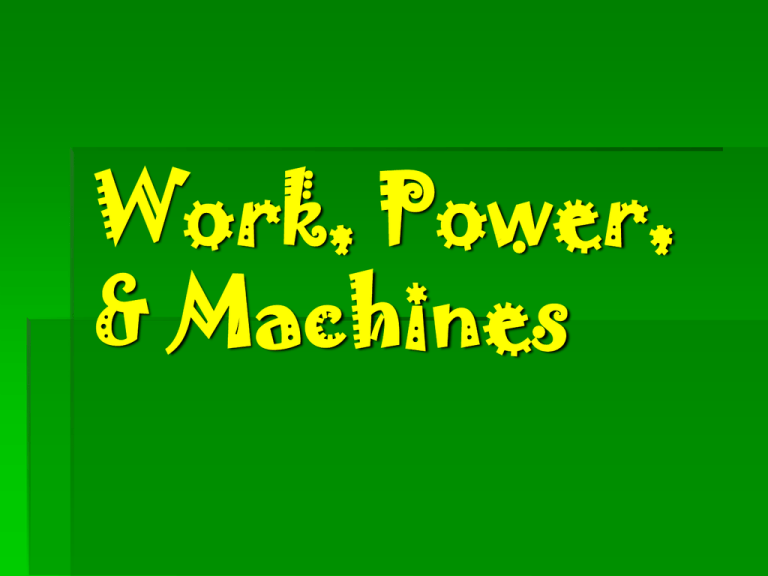
Work, Power, & Machines What is work ? The product of the force applied to an object and the distance through which that force is applied. Is work being done or not? Mowing the lawn Weight-lifting Moving furniture up a flight of stairs Pushing against a locked door Swinging a golf club YES YES YES NO YES Calculating Work All or part of the force must act in the direction of the movement. Do you do more work when you finish a job quickly? Work does NOT involve time, only force and distance. No work is done when you stand in place holding an object. Labeling work: w = F x d Newton X meter (N m) Which also = (kg x m2) s2 The Joule 1 newton-meter is a quantity known as a joule (J). Named after British physicist James Prescott Joule. Work Example Problem 1. How much work is done if a chair is lifted 6m with a force of 10N? We know W= F x d From the problem we have that: d= 6m F= 10 N Therefore: W=(10N)(6m) W=60 N.m or W=60 J Now try to solve the following problems 1. How much work is done if I move a book with a force of 5N, 5m? 2. How much work is done if I push on a wall with a force of 50N but the wall does not move? 3. Calculate the amount of work that can be done by a hammer hitting a nail 0.03m with a force of 3N. 4. How much work is done if an elephant lifts a clown up in the air 6m using a force of 25 N? 5. How much work is done if I move a 5N book 5m? 6. Calculate the amount of work required to push a piano 3m with a force of 10 N ? For honors science. 7. You did 50J of work to lift a 25N object. How high did you lift the object 8. You did 300J of work to move a 1000N piano. How far did you move the piano? 9. You lift a 500N object 3m. How much energy did you put into the object? What will happen to the energy contained in the object when you drop it? Now answer the following questions in your journal… 1. What two things are necessary for work to be done on an object? 2. Work is done on a ball when a pitcher throws it. Is the pitcher still doing work on the ball as it flies through the air? Draw a picture to explain your answer. 3. Suppose you lift a 75 N bowling ball 2 m off the floor. How much work do you do? 4. Why are simple machines like a lever or a pulley important to your muscular system? 5. Explain why is no work done when you are applying a force against a wall. Draw a diagram to explain your example. How quickly work is done. Amount of work done per unit time. If two people mow two lawns of equal size and one does the job in half the time, who did more work? Same work. Different power exerted. POWER = WORK / TIME The watt A unit named after Scottish inventor James Watt. Invented the steam engine. P = W/t Joules/second 1 watt = 1 J/s watts Used to measure power of light bulbs and small appliances An electric bill is measured in kW/hrs. 1 kilowatt = 1000 W Horsepower (hp) = 745.5 watts Traditionally associated with engines. (car,motorcycle,lawn-mower) The term horsepower was developed to quantify power. A strong horse could move a 750 N object one meter in one second. 750 N Machines A device that makes work easier. A machine can change the size, the direction, or the distance over which a force acts. Forces involved: Input Force Output Force FO FI Force Force applied by applied to a machine a machine Two forces, thus two types of work Work Input work done on a machine =Input force x the distance through which that force acts (input distance) Work Output Work done by a machine =Output force x the distance through which the resistance moves (output distance) Can you get more work out than you put in? Work output can never be greater than work input. Mechanical Advantage (MA) – expressed in a ratio WITH NO UNITS!! The number of times a machine multiplies the input force. 2 types of mechanical advantage IDEAL Involves no friction. Is calculated differently for different machines Usually input distance/output distance ACTUAL Involves friction. Calculated the same for all machines Different mechanical advantages: MA equal to one. (output force = input force) Change the direction of the applied force only. Mechanical advantage less than one An increase in the distance an object is moved (do) Efficiency Efficiency can never be greater than 100 %. Why? Some work is always needed to overcome friction. A percentage comparison of work output to work input. work output (WO) / work input (WI) 1. The Lever A bar that is free to pivot, or move about a fixed point when an input force is applied. Fulcrum = the pivot point of a lever. There are three classes of levers based on the positioning of the effort force, resistance force, and fulcrum. First Class Levers Fulcrum is located between the effort and resistance. Makes work easier by multiplying the effort force AND changing direction. Examples: Second Class Levers Resistance is found between the fulcrum and effort force. Makes work easier by multiplying the effort force, but NOT changing direction. Examples: Third Class Levers Effort force is located between the resistance force and the fulcrum. Does NOT multiply the effort force, only multiplies the distance. Examples: Levers!!!!!!!!!!! Mechanical advantage of levers. Ideal = input arm length/output arm length input arm = distance from input force to the fulcrum output arm = distance from output force to the fulcrum 2. The Wheel and Axle A lever that rotates in a circle. A combination of two wheels of different sizes. Smaller wheel is termed the axle. IMA = radius of wheel/radius of axle. 3. The Inclined Plane A slanted surface used to raise an object. Examples: ramps, stairs, ladders IMA = length of ramp/height of ramp Can never be less than one. 4. The Wedge An inclined plane that moves. Examples: knife, axe, razor blade Mechanical advantage is increased by sharpening it. 5. The Screw An inclined plane wrapped around a cylinder. The closer the threads, the greater the mechanical advantage Examples: bolts, augers, drill bits 6. The Pulley A chain, belt , or rope wrapped around a wheel. Can either change the direction or the amount of effort force Ex. Flag pole, blinds, stage curtain Pulley types FIXED Can only change the direction of a force. MA = 1 MOVABLE Can multiply an effort force, but cannot change direction. MA > 1 MA = Count # of ropes that apply an upward force (note the block and tackle!) Fe A combination of two or more simple machines. Cannot get more work out of a compound machine than is put in.
